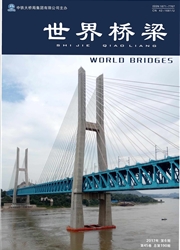

 中文摘要:
中文摘要:
为探讨我国规范中混凝土箱梁温度梯度取值的合理性,收集了全国28个主要城市64年的气象数据资料,基于气象参数,采用有限元法,研究了混凝土箱梁的最大竖向和横向温度梯度曲线及取值,拟合了采用日太阳辐射强度、日最高最低温度和日平均风速表示的最大温度梯度计算公式,并与既有规范进行了对比。研究表明:受地理位置影响,我国不同地区的最大温度梯度值有一定差别;基于日太阳辐射强度、日最高最低温度和日平均风速计算得到的梯度取值公式可用于估算我国不同地区的最大温度梯度值;短翼缘板箱梁在顶板和底板均有较大的横向温度梯度,在设计中不容忽视;公路桥规的统一温度梯度取值明显高估我国部分地区的最大温度梯度,需根据当地的气候条件合理取值。
 英文摘要:
英文摘要:
To examine the rationality of the temperature gradient values for concrete box girder in the Chinese codes,the meteorological data of 28 main cities in China in 64 years have been collected.Based on the meteorological parameters,the finite element method was used to study the maximum vertical and transverse temperature gradient curves and values of the concrete box girder.According to the findings of the study,the calculation formula for the maximum temperature gradient expressed by the intensity of daily solar radiation,the highest and lowest daily temperatures and the average daily wind speed is fit,and the calculated values are compared with the values prescribed in the code.The study indicates that there is a difference among the maximum temperature gradient values in different regions in China due to the influence of the geological condition.The formula for calculating the gradient values based on the intensity of daily solar radiation,the highest and lowest daily temperatures and the average daily wind speed is applicable to estimate the maximum temperature gradient values in different regions in China.For the box girder with short flange plates,there are big transverse temperature gradients in both the top and bottom plates,which should not be ignored in the design.The uniform temperature gradient values in the road specifications obviously overestimate the maximum temperature gradients of some regions in China.Therefore,it is necessary to choose the rational values according to the different local weather conditions.
 同期刊论文项目
同期刊论文项目
 同项目期刊论文
同项目期刊论文
 期刊信息
期刊信息
